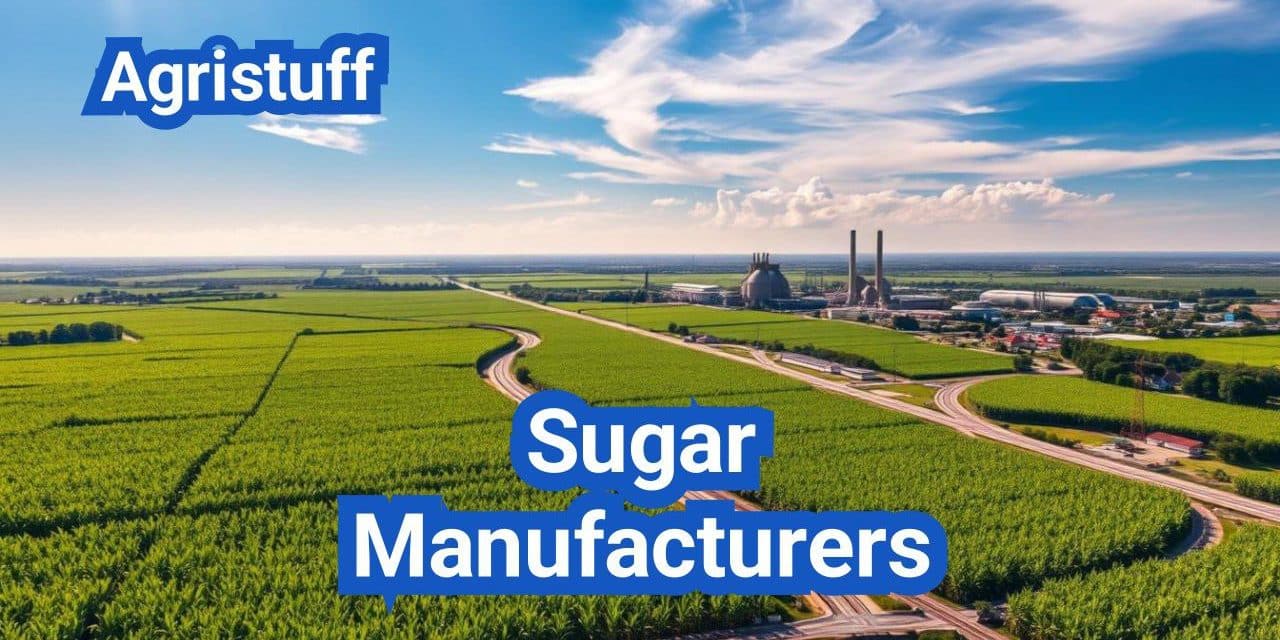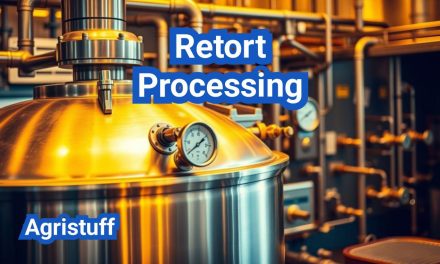The United States is a significant player in the global sugar industry, with a well-developed sugarcane and sugarbeet production system.
The U.S. is among the world’s largest sugar producers ( Sugar Manufacturers ) , with both large and well-developed sugarcane and sugarbeet industries contributing to its position.
The country’s sugar production is primarily derived from two sources: sugarcane, mainly grown in Florida, Louisiana, and Texas, and sugar beets, primarily cultivated in the Great Plains and Northwest.
Key Takeaways
- The U.S. is a major player in global sugar production.
- Sugarcane and sugar beets are the primary sources of sugar.
- The U.S. sugar industry is well-developed and significant.
- Major sugarcane-producing states include Florida, Louisiana, and Texas.
- Sugar beets are primarily grown in the Great Plains and Northwest regions.
The U.S. Sugar Industry at a Glance
With its origins in the 1700s, the U.S. sugar industry has evolved significantly over time. The industry’s history is marked by significant milestones, including the first sugarcane planting in Louisiana in 1751.
Historical Development of Sugar Production in America
The U.S. sugar industry began with sugarcane cultivation in Louisiana, which laid the foundation for the industry’s growth. Over the 19th century, sugar production expanded across the southern United States, driven by advancements in technology and changes in agricultural practices.
Sugarcane production became a significant agricultural activity, particularly in Louisiana and later in Florida. The industry’s historical development is a testament to the adaptability and innovation of American sugar producers.
Economic Impact and Market Size
The U.S. sugar industry is a substantial contributor to the national economy. It generates employment opportunities in rural areas and supports related industries such as agriculture and manufacturing. The industry’s economic impact is felt across various sectors, from farming to refining.
The market size of the U.S. sugar industry is considerable, with the country producing a significant portion of its sugar needs. The industry is characterized by a mix of large producers and smaller, specialized operations.
Key Production Regions Across the Country
The United States is home to several key sugar-producing regions. The southern states, particularly Louisiana and Florida, are prominent for sugarcane production. Other significant production areas include the Great Plains and the Northwest, where sugar beets are a major crop.
The diversity of sugar-producing regions in the U.S. allows for a stable supply of sugar throughout the year, supporting both domestic consumption and export markets.
How to Understand Sugar Sources: Cane vs. Beet

Understanding the sources of sugar is crucial, and in the U.S., it primarily comes from sugarcane and sugar beets. These two crops have different cultivation requirements and are grown in different regions, impacting their yield, cost, and quality.
Sugar Cane: Cultivation Requirements and Growing Regions
Sugarcane is a tropical crop that thrives in warm, humid climates. It requires a long growing season with high temperatures and adequate rainfall. In the United States, sugarcane is primarily grown in Florida, Louisiana, and Hawaii. The crop is typically harvested between October and March, depending on the region.
Cultivation Requirements: Sugarcane needs well-drained soil and a frost-free environment. It is usually grown on large plantations and requires significant irrigation and fertilization.
Sugar Beets: Climate Conditions and Production Areas
Sugar beets, on the other hand, are grown in temperate climates with cooler temperatures. They are more tolerant of frost than sugarcane and can be grown in a variety of soil types. Major sugar beet production areas in the U.S. include the Red River Valley of Minnesota and North Dakota, as well as parts of Idaho, Michigan, and Wyoming.
Climate Conditions: Sugar beets prefer cooler temperatures and can be grown in areas with moderate rainfall. They are typically planted in the spring and harvested in the fall.
Comparing the Two Sources: Yield, Cost, and Quality Differences
Sugarcane and sugar beets have different yields, production costs, and sugar quality. Sugarcane typically has a higher yield per acre and is more cost-effective to process. However, sugar beets can be grown in areas where sugarcane cannot, providing a significant portion of the U.S. sugar supply.
| Crop | Yield (tons/acre) | Production Cost ($/ton) | Sugar Content (%) |
|---|---|---|---|
| Sugarcane | 30-40 | 25-35 | 12-15 |
| Sugar Beets | 20-30 | 30-40 | 16-20 |
The choice between sugarcane and sugar beets depends on regional climate conditions, agricultural practices, and market demand. Both crops are essential to meeting the U.S. sugar demand, with sugar beets accounting for approximately 55-60% of production and sugarcane making up the remaining 40-45%.
The Journey from Plant to Product: Sugar Manufacturing Process
From harvesting to crystallization, the journey of sugar production involves meticulous processing techniques. The sugar manufacturing process transforms raw sugarcane or sugar beets into refined sugar, a product used globally.
Cane Sugar Processing: Harvesting to Crystallization
Cane sugar processing begins with harvesting mature sugarcane. The cane must be processed quickly after harvesting to maximize sugar content. The processing involves several steps: extraction, purification, and crystallization. Extraction is typically done through crushing or diffusion. The juice is then clarified and evaporated to produce a syrup, which is further crystallized to yield raw sugar.
Beet Sugar Extraction and Processing Steps
Sugar beets, on the other hand, can be stored for short periods before processing. Beet sugar extraction involves slicing beets into cossettes, which are then soaked in hot water to extract the sugar. The resulting juice is purified and concentrated through evaporation. The thick juice is then seeded with sugar crystals to induce crystallization. The final step involves centrifugation to separate the sugar crystals from the molasses.
Refining Methods and Quality Control Measures
Refining raw sugar to produce white sugar involves several steps, including affination, clarification, and decolorization. The raw sugar is first mixed with a syrup to remove the outer layer, then clarified to remove impurities. The clear syrup is then decolorized using ion exchange or carbonatation. Quality control measures are implemented throughout the refining process to ensure the production of high-quality sugar. These measures include regular testing for purity, color, and moisture content.
The refined sugar is then packaged and distributed to food manufacturers and retailers. The entire process, from harvesting to the final product, requires precision and adherence to quality standards to produce the sugar that ends up on our tables.
Leading Sugar Manufacturers in the U.S. Market

The U.S. sugar market is dominated by several key players who shape the industry’s landscape. These leading sugar manufacturers play a crucial role in the production and distribution of sugar across the country.
Corporate Structures and Ownership Models
The corporate structures of major sugar manufacturers in the U.S. vary, with some operating as cooperatives and others as private or publicly traded companies. For instance, Florida Crystals is a prominent player known for its integrated operations, from farming to refining. In contrast, American Crystal Sugar operates as a farmer-owned cooperative, highlighting the diverse ownership models within the industry.
Market Share Distribution Among Major Players
The U.S. sugar market is characterized by a concentrated market share among a few large companies. The distribution is influenced by factors such as production capacity, geographical presence, and market demand. Companies like Domino Sugar and U.S. Sugar Corporation have significant market shares, contributing to the competitive dynamics of the industry.
- Florida Crystals: Known for its extensive sugar cane operations in Florida.
- American Crystal Sugar: A major producer of beet sugar in the Red River Valley.
- Domino Sugar: A leading refiner of sugar, with operations across the U.S.
How to Identify the Biggest Sugar Companies
Identifying the biggest sugar companies involves analyzing their production volumes, revenue, and market presence. Factors such as the size of their operations, the extent of their distribution networks, and their role in the supply chain are critical indicators. Companies with significant refining capacities and those that are vertically integrated tend to be among the largest players.
To understand the market dynamics, it’s essential to look at the market share distribution and the corporate structures of these leading manufacturers. This analysis provides insights into how these companies influence the U.S. sugar market.
Cane Sugar Powerhouses: Southern Operations
The southern United States is home to some of the most significant cane sugar producers in the country. This region’s favorable climate and extensive agricultural infrastructure make it an ideal location for large-scale cane sugar production.
Florida Crystals Corporation: Facilities and Output
Florida Crystals Corporation is one of the largest cane sugar producers in the United States. With operations based in Florida, the company has a significant presence in the country’s cane sugar market. Florida Crystals operates multiple sugar mills and refineries, enabling it to control a substantial portion of its production process from harvesting to final product.
The company’s facilities are equipped with modern technology to maximize efficiency and output. Florida Crystals’ commitment to quality and sustainability has positioned it as a leader in the industry.
Sugar Cane Growers Cooperative of Florida
The Sugar Cane Growers Cooperative of Florida is another major player in the U.S. cane sugar industry. As a cooperative, it is owned by its member growers, who benefit from shared resources and expertise. This model allows for more efficient operations and better market positioning.
The cooperative operates a large sugar mill and has a significant production capacity, contributing substantially to Florida’s cane sugar output. Its operations are focused on producing high-quality sugar while maintaining environmentally friendly practices.
Louisiana Sugar Mills and Their Production Capacity
Louisiana Sugar Mills is a key cane sugar producer in Louisiana, with a long history of sugar production in the state. The company operates several sugar mills and has a considerable production capacity, making it a vital part of Louisiana’s agricultural economy.
Louisiana Sugar Mills is known for its efficient harvesting and processing operations, which enable it to produce high-quality cane sugar. The company’s commitment to innovation and sustainability has helped it maintain a competitive edge in the market.
U.S. Sugar Corporation Profile
U.S. Sugar Corporation is a major integrated agricultural company with significant operations in cane sugar production. Based in Florida, the company is involved in all aspects of sugar production, from growing and harvesting sugarcane to processing and refining sugar.
U.S. Sugar Corporation’s operations are characterized by their scale and efficiency. The company has invested heavily in its facilities and technology, allowing it to produce high-quality sugar products while minimizing its environmental impact.
Beet Sugar Giants: Northern Production Networks

The northern United States is home to several key players in the beet sugar industry. These companies are crucial to the production of beet sugar, operating extensive networks across the northern states.
American Crystal Sugar Company stands out as a significant player in the Red River Valley region. As a farmer-owned cooperative, it represents a substantial portion of the beet sugar production in the area. The company’s structure allows it to maintain strong ties with local farmers, ensuring a stable supply of sugar beets.
American Crystal Sugar Company: Farmer-Owned Cooperative
American Crystal Sugar Company is not only a major producer but also a cooperative that benefits its member farmers. By working together, the farmers can negotiate better prices and share the risks associated with sugar beet cultivation.
Michigan Sugar Company: Structure and Operations
Michigan Sugar Company is another prominent beet sugar producer in the northern U.S. It operates processing facilities in Michigan, serving local farmers and contributing to the regional economy. The company’s operations are tailored to the specific needs of Michigan’s sugar beet growers.
Amalgamated Sugar in Idaho: Processing Capabilities
Amalgamated Sugar, located in Idaho, is known for its advanced processing capabilities. The company plays a vital role in the regional beet sugar production, leveraging its expertise to produce high-quality sugar.
Western Sugar Cooperative: Multi-State Presence
Western Sugar Cooperative has a significant presence across multiple states, including Colorado, Wyoming, Montana, and Nebraska. This cooperative structure enables farmers to pool resources, enhancing their market position and operational efficiency.
The beet sugar giants in the northern U.S. are pivotal to the industry, driving production and innovation. Their cooperative structures and advanced processing capabilities make them key players in the global sugar market.
Sugar Refining Operations: From Raw to Retail

The journey from raw sugar to the refined sugar on grocery store shelves involves complex refining operations. Sugar refining is a critical process that transforms raw sugar into various products that consumers use daily.
Domino Sugar Refineries: Locations and Capacity
Domino Sugar is one of the prominent players in the U.S. sugar refining industry. With refineries located in key strategic areas, Domino Sugar has a significant refining capacity. The company’s refineries are equipped with advanced technology to ensure high-quality refined sugar products.
Key Features of Domino Sugar Refineries:
- Advanced refining technology
- Strategic locations for efficient distribution
- High-capacity refining facilities
American Sugar Refining Group (ASR): The Industry Leader
American Sugar Refining Group (ASR) is a leading refiner of sugar in the United States. ASR operates multiple refineries across the country, producing a wide range of sugar products. The company’s refining operations are known for their efficiency and commitment to quality.
ASR’s Refining Capabilities:
- Multi-location refining presence
- Diverse product portfolio
- State-of-the-art refining facilities
Imperial Sugar and Regional Refining Facilities
Imperial Sugar is another significant player in the U.S. sugar refining sector. The company operates regional refining facilities that cater to the local market demands. Imperial Sugar’s refining operations are focused on producing high-quality sugar products.
The refining process involves several steps, including:
- Receiving and storing raw sugar
- Melting raw sugar to create a syrup
- Filtering and decolorizing the syrup
- Crystallizing the sugar
- Drying and packaging the final product
These refining operations are crucial for delivering high-quality sugar products to consumers across the United States.
Navigating Sugar Brands and Their Manufacturers

The American sugar industry is characterized by a multitude of brands, each with its own manufacturer. This diversity can make it challenging for consumers to understand the different sugar brands available in the market.
Major Retail Sugar Brands in the U.S. Market
The U.S. market is home to several prominent retail sugar brands. Domino Sugar, C&H Sugar, and Florida Crystals are among the most recognized names. These brands are widely available in supermarkets and online.
| Brand Name | Manufacturer | Product Type |
|---|---|---|
| Domino Sugar | Domino Sugar Refineries | Refined Sugar |
| C&H Sugar | C&H Sugar Company | Raw and Refined Sugar |
| Florida Crystals | Florida Crystals Corporation | Raw Cane Sugar |
Private Label and Store Brands: Who Makes Them
Private label and store brands are also significant players in the U.S. sugar market. These brands are often manufactured by the same companies that produce name-brand sugar products. For instance, some of the major sugar manufacturers produce sugar for store brands.
“The private label segment has seen significant growth as consumers look for affordable alternatives to name-brand products.”
How to Trace Sugar Products to Their Source
Tracing sugar products to their source can be done by checking the packaging for manufacturer information or looking up the brand’s website. Many manufacturers provide details about their production processes and sourcing.
- Check the packaging label for the manufacturer’s name and contact information.
- Visit the brand’s official website for more information on their production and sourcing practices.
- Contact the customer service department of the brand or manufacturer directly.
By understanding the different sugar brands and their manufacturers, consumers can make more informed choices about the sugar products they purchase.
U.S. Sugar Policy: How Regulation Shapes the Industry

U.S. sugar policy has a profound impact on both domestic production and international trade. The sugar industry operates within a complex regulatory framework that influences production levels, pricing, and imports.
USDA Sugar Program Fundamentals
The USDA administers the sugar program, which provides support to sugar producers through loans and import quotas. “The sugar program is designed to stabilize the domestic sugar market, ensuring a stable supply and fair prices for producers and consumers alike,” as stated by the USDA. The program sets the foundation for the industry’s operation, affecting how much sugar is produced and at what price.
The USDA sugar program includes non-recourse loans to sugar processors, allowing them to borrow money using their sugar as collateral. This mechanism helps stabilize the market by providing financial support to processors.
Tariff-Rate Quotas (TRQ) and Import Controls
Tariff-Rate Quotas (TRQ) are a critical component of U.S. sugar policy, regulating the amount of sugar that can be imported. TRQs allow a certain quantity of sugar to enter the country at a lower tariff rate, while additional imports are subject to higher tariffs. This system helps control the supply of sugar in the domestic market.
Key aspects of TRQ include:
- Quantity control: Limiting the amount of sugar imported.
- Tariff rates: Applying lower tariffs to quota amounts and higher tariffs to excess imports.
Domestic Support Programs and Price Stabilization
Domestic support programs, including marketing allotments and price support mechanisms, play a crucial role in stabilizing the sugar market. These programs help maintain a balance between supply and demand, ensuring that prices remain stable for both producers and consumers.
By implementing these programs, the U.S. government aims to prevent market fluctuations that could negatively impact the industry. As a result, the sugar industry can maintain a stable production level, benefiting both farmers and consumers.
The interplay between these regulatory measures creates a complex environment for the U.S. sugar industry. Understanding these policies is essential for stakeholders, from farmers to consumers, to navigate the market effectively.
Seasonal Production Cycles in Sugar Manufacturing

Seasonal fluctuations play a crucial role in determining the production schedules of sugar manufacturers across the United States. The U.S. sugar industry is characterized by two main types of sugar crops: sugar beets and sugarcane, each with its own harvesting and processing seasons.
Beet Processing Campaign: Timing and Operations
Sugar beets are typically harvested in the fall, with the exact timing varying by region. The beet processing campaign usually starts in September or October and can last until December or January, depending on the weather conditions and the availability of beets.
During this period, sugar manufacturers operate at full capacity to process the beets into sugar. The processing involves slicing the beets, extracting the juice, and then purifying and crystallizing the sugar.
Cane Harvesting Seasons and Processing Windows
Sugarcane, on the other hand, is harvested between October and March, with the peak season usually occurring between December and February. The cane harvesting season is influenced by regional factors, including weather conditions and the maturity of the cane.
Cane sugar processing involves harvesting the mature cane, extracting the juice, and then clarifying, evaporating, and crystallizing the sugar. The processing windows are critical, as delays can result in reduced sugar quality and yield.
Weather Impacts on Production Schedules
Weather conditions have a significant impact on both beet and cane sugar production. Unseasonable weather, such as excessive rain or frost, can damage the crops and disrupt the harvesting and processing schedules.
For instance, heavy rainfall during the harvesting season can make it difficult to access the fields, leading to delays in harvesting and processing. Similarly, frost can damage the sugar beets, reducing their quality and yield.
| Crop | Harvesting Season | Processing Period | Weather Sensitivity |
|---|---|---|---|
| Sugar Beets | Fall (September – November) | September – January | High (frost, excessive rain) |
| Sugarcane | October – March | October – April | High (frost, hurricanes) |
Understanding these seasonal production cycles and their sensitivities to weather conditions is crucial for sugar manufacturers to plan and optimize their operations effectively.
Sustainability Initiatives Among U.S. Sugar Manufacturers

As concerns about environmental impact grow, U.S. sugar manufacturers are turning to sustainable practices. This shift is driven by both regulatory pressures and a genuine commitment to reducing their ecological footprint.
Environmental Practices in Modern Sugar Production
Modern sugar production in the U.S. incorporates various environmental practices aimed at minimizing the industry’s impact on the environment. These include the use of more efficient irrigation systems and the implementation of crop rotation and conservation tillage to reduce soil erosion.
Efficient irrigation systems help reduce water consumption, a critical resource in sugar production. Additionally, conservation tillage and crop rotation enhance soil health, reduce the need for chemical inputs, and promote biodiversity.
Water Conservation and Energy Efficiency Measures
Water conservation is a critical aspect of sustainable sugar production. Manufacturers are adopting advanced technologies to reduce water usage in both cultivation and processing stages. For instance, precision agriculture techniques allow for more targeted water application, reducing waste and conserving this vital resource.
Energy efficiency is another key area of focus. Many sugar manufacturers are transitioning to renewable energy sources and implementing energy-efficient processing technologies to reduce their carbon footprint.
Waste Reduction and Byproduct Utilization
The U.S. sugar industry has made significant strides in waste reduction and byproduct utilization. Bagasse, a byproduct of sugar cane processing, is used as a biomass fuel to generate electricity and steam, reducing the industry’s reliance on fossil fuels.
Moreover, efforts to minimize waste include recycling water and reusing process byproducts. For example, molasses, another byproduct, is used in animal feed and ethanol production, further reducing waste and adding value to the production process.
How U.S. Sugar Manufacturers Compare Globally

As one of the world’s largest sugar producers, the United States faces stiff competition from international suppliers. The global sugar industry is characterized by a mix of large producers, with countries like Brazil, India, and Thailand playing significant roles alongside the U.S.
America’s Position in World Sugar Production
The U.S. is among the top sugar-producing countries globally, with a significant portion of its production coming from both sugarcane and sugar beets. The country’s sugar industry is well-established, with major production areas in states like Florida, Louisiana, and Idaho.
Key statistics highlighting the U.S. position include:
- Annual sugar production: approximately 8 million tons
- Major production regions: Florida, Louisiana, Minnesota, and Idaho
- Both sugarcane and sugar beets are cultivated to meet domestic demand
Comparison with Brazilian and Other International Suppliers
Brazil stands out as the world’s largest sugar producer, accounting for a substantial portion of global sugar output. Brazilian sugar suppliers have a competitive edge due to favorable climate conditions and large-scale production capabilities.
Key differences between U.S. and Brazilian sugar production include:
- Climate: Brazil’s tropical climate allows for more extensive sugarcane cultivation
- Production costs: Labor and land costs in Brazil are generally lower than in the U.S.
- Scale: Brazilian sugar producers operate on a larger scale, influencing global market prices
Global Market Competition and Trade Dynamics
The global sugar market is highly competitive, with trade dynamics influenced by factors such as production costs, government subsidies, and international trade agreements. U.S. sugar manufacturers must navigate this complex landscape to remain competitive.
Key factors affecting global market competition include:
- Tariffs and quotas imposed by governments to protect domestic industries
- Fluctuations in global sugar prices due to supply and demand imbalances
- Increasing demand for sustainable and ethically produced sugar
The Future of U.S. Sugar Manufacturing
The U.S. sugar industry continues to evolve, driven by technological advancements and shifting global market conditions. As we look to the future of U.S. sugar manufacturing, it’s clear that the industry will continue to adapt to changing circumstances, including fluctuations in global sugar prices and advancements in production technology.
Leading sugar manufacturers, such as Florida Crystals Corporation and American Crystal Sugar Company, are at the forefront of this evolution, investing in sustainable practices and improving operational efficiency. The U.S. sugar industry outlook remains positive, with domestic demand expected to remain stable and opportunities for growth in export markets.
As the industry moves forward, it will be shaped by a combination of factors, including government policies, environmental considerations, and market trends. By understanding these dynamics, stakeholders can better navigate the complexities of the U.S. sugar market and capitalize on emerging opportunities.
FAQ
What are the primary sources of sugar in the U.S.?
The primary sources of sugar in the U.S. are sugarcane and sugar beets.
How does the U.S. rank in global sugar production?
The U.S. is among the top sugar-producing countries globally, with a significant portion coming from both sugarcane and sugar beets.
What are the key production regions for sugarcane and sugar beets in the U.S.?
Sugarcane is primarily grown in Florida, Louisiana, and Texas, while sugar beets are cultivated in the upper Midwest and Western states, including Minnesota, North Dakota, and Idaho.
What is the difference between cane sugar and beet sugar?
Cane sugar and beet sugar differ in their cultivation requirements, yield, cost, and quality. Cane sugar is generally produced in tropical and subtropical regions, while beet sugar is produced in temperate zones.
How is sugar manufactured from sugarcane and sugar beets?
Sugar manufacturing involves harvesting, processing, and refining. Cane sugar processing includes harvesting, crushing, and crystallization, while beet sugar extraction involves slicing beets, diffusing sugar, and purifying the juice.
Who are the leading sugar manufacturers in the U.S.?
Leading sugar manufacturers in the U.S. include Florida Crystals Corporation, American Crystal Sugar Company, Michigan Sugar Company, and U.S. Sugar Corporation.
What is the role of the USDA in the U.S. sugar industry?
The USDA plays a crucial role in regulating the U.S. sugar industry through programs such as the sugar program, tariff-rate quotas, and domestic support programs.
How do seasonal production cycles affect sugar manufacturing?
Seasonal production cycles impact sugar manufacturing, with beet processing typically occurring in the fall and winter, and cane harvesting happening between October and March.
What sustainability initiatives are being implemented by U.S. sugar manufacturers?
U.S. sugar manufacturers are implementing various sustainability initiatives, including environmental practices, water conservation, energy efficiency, and waste reduction.
How does the U.S. sugar industry compare to global competitors?
The U.S. sugar industry competes with global suppliers, particularly Brazil, and is influenced by global market dynamics and trade agreements.
What are the major retail sugar brands in the U.S. market?
Major retail sugar brands in the U.S. include Domino Sugar, C&H Sugar, and Florida Crystals, among others.
How can consumers identify the manufacturers of sugar products?
Consumers can identify the manufacturers of sugar products by checking the packaging for company names or logos, or by researching online.
Conclusion of: Sugar Manufacturers In USA
What U.S. sugar manufacturers actually make: cane, beet, refined, and specialty
When people talk about sugar manufacturers in the U.S., they’re referring to two closely linked industries: cane sugar and beet sugar. Cane is grown in warm, frost-limited regions and milled into raw sugar that is later refined; beets are grown in cooler states and typically processed straight to refined sugar in large factories. Together, these sugar manufacturers supply one of the world’s largest sugar markets, with beet sugar historically providing a little over half and cane sugar the remainder. USDA ERS: Sugar & Sweeteners overview
Where U.S. sugar comes from: the map behind sugar manufacturers
The footprint of U.S. sugar manufacturers spans coast-to-coast. Beet sugar is concentrated in the Red River Valley (MN/ND) and across ID, MI, MT, NE, WY and CO, while cane sugar is grown and milled in Florida and Louisiana today. This geography explains why sugar manufacturers operate a network of mills, refineries, and distribution hubs near farms and ports. The Sugar Association: U.S. sugar map
Policy & market design that shape sugar manufacturers’ decisions
U.S. sugar manufacturers operate within a specific policy framework that balances supply and demand through marketing allotments, price support loans, and import management. This structure helps stabilize prices and planning for sugar manufacturers, but it also means imports are tightly managed. USDA ERS: Sugar policy basics
Imports & the TRQ system: what it means for sugar manufacturers
Because domestic output doesn’t always meet demand, sugar manufacturers and buyers rely on imports administered via tariff-rate quotas (TRQs). USDA sets the in-quota quantity each fiscal year, and USTR allocates it to supplying countries. This system is a major planning input for sugar manufacturers and large buyers across retail and foodservice. USTR: Sugar TRQs explained
Fresh allocations that affect sugar manufacturers
Recent TRQ announcements also matter for sugar manufacturers because they influence refined and specialty sugar availability for packers and brands. For FY 2026, USTR announced refined and specialty sugar TRQ allocations and first-come, first-served amounts that downstream buyers and sugar manufacturers watch closely. Federal Register: FY2026 TRQ allocations
Florida & Louisiana: the cane side of U.S. sugar manufacturers
On the cane side, sugar manufacturers cluster in South Florida and southern Louisiana. Cane is harvested, milled into raw sugar at seasonal mills, then refined year-round to food-grade sugar. Understanding this flow helps buyers plan with sugar manufacturers for peak harvest windows and steady refined output. American Sugar Cane League: Learn about Louisiana cane
Red River Valley & beyond: the beet side of U.S. sugar manufacturers
For beet-based sugar manufacturers, harvest happens in autumn when beets are lifted and stored in temperature-controlled piles before factory “campaigns” run nearly around the clock. These factories—especially in Minnesota, North Dakota, Idaho, and Michigan—anchor year-round refined sugar supply from sugar manufacturers. USDA ERS Outlook: beet states & harvest notes
Texas update: a shift all sugar manufacturers noticed
In 2024, Texas’s last cane mill shut down due to prolonged water shortages—an event closely watched by sugar manufacturers nationwide because of its supply-chain ripple effects. The Rio Grande Valley Sugar Growers’ official release documents how water availability can reshape where sugar manufacturers operate. Rio Grande Valley Sugar Growers: Closure press release
Meet major cane sugar manufacturers: ASR Group (Domino, C&H)
ASR Group—owner of Domino® and C&H®—is the world’s largest cane sugar refiner and a key partner to U.S. sugar manufacturers and retailers. Its U.S. refinery network in New York, Maryland, Louisiana and California gives sugar manufacturers coast-to-coast reach and resilience. ASR Group: About & scale
Refineries that keep sugar manufacturers supplied year-round
ASR’s refineries—including Yonkers (NY), Baltimore (MD), and Chalmette (LA)—are pivotal for sugar manufacturers to move raw cane sugar to food-grade product on a steady cadence. This network underpins continuity for industrial users and brands sourcing from U.S. sugar manufacturers. Domino Sugar: U.S. refinery locations
Florida Crystals & the cooperative partners behind cane sugar manufacturers
Florida Crystals operates an integrated farming, milling, and refining system in South Florida and, with partners, supports the refining capacity that many sugar manufacturers depend on. Their sustainability and organic programs also influence packaging, claims, and buyer expectations for sugar manufacturers. Florida Crystals Corporation: Company overview
Sugar Cane Growers Cooperative: growers powering cane sugar manufacturers
The Sugar Cane Growers Cooperative of Florida supplies raw sugar into the refining system serving U.S. markets. This grower base and its logistics are central to the planning cycles of downstream sugar manufacturers, retailers, and food companies. Sugar Cane Growers Cooperative of Florida
Beet leaders among sugar manufacturers: American Crystal Sugar Company
American Crystal Sugar Company is one of the nation’s largest beet sugar manufacturers, operating factories across Minnesota and North Dakota. Their Red River Valley footprint provides reliable refined supply to bakeries, beverage producers, and national brands that work with sugar manufacturers. American Crystal: Factory locations
Michigan Sugar Company: grower-owned beet sugar manufacturers
Michigan Sugar Company, a grower-owned cooperative, runs multiple beet factories and distribution hubs across the Great Lakes region. Its vertically organized operations help sugar manufacturers maintain steady deliveries and service levels for Midwest customers. Michigan Sugar: Official site
Amalgamated Sugar: Intermountain supply from beet sugar manufacturers
Amalgamated Sugar operates major beet factories in Nampa, Paul, and Twin Falls, Idaho, providing significant Intermountain West capacity among U.S. sugar manufacturers. The company’s cooperative model and long processing “campaigns” keep product flowing to regional markets. Amalgamated Sugar: Company overview
Western Sugar Cooperative: Rocky Mountain beet sugar manufacturers
Western Sugar Cooperative processes beets in Colorado, Nebraska, Wyoming, and Montana, anchoring a multi-state footprint of beet sugar manufacturers. Its regional plants add resiliency and proximity for western customers needing reliable refined sugar. Western Sugar: Facilities
Marketing & distribution that link sugar manufacturers to buyers
Several producers jointly market and distribute sugar to national accounts—an example is United Sugars Corporation, a leading marketer representing multiple beet and cane firms. This coordination lets sugar manufacturers serve large food and beverage companies with scale and consistency. United Sugars: Ownership & role (press release)
Refining & logistics: how sugar manufacturers keep the shelf stocked
From a logistics standpoint, refinery and warehouse locations are critical. Ports and inland hubs near factories help sugar manufacturers move raw and refined sugar efficiently to bakeries, bottlers, and retailers nationwide, keeping inventories stable across seasons. ASR Group: Refinery logistics information
Labeling & compliance: what sugar manufacturers must follow
On the regulatory side, sugar manufacturers and brands must declare “Added Sugars” on the Nutrition Facts label, and many buyers align specs to FDA guidance. Understanding these rules helps sugar manufacturers support clean, consistent labeling for retail and foodservice. FDA: Added Sugars on the Nutrition Facts Label
Why policy stability and imports planning matter to sugar manufacturers
Because demand is steady but weather and yields vary, sugar manufacturers plan around USDA supply/demand updates and annual import allocations. Clear TRQ calendars and consistent domestic campaigns help sugar manufacturers keep bakers, beverage companies, and grocers supplied. USDA ERS: Sugar trade & TRQs
Sustainability & operations: how sugar manufacturers are evolving
Many U.S. sugar manufacturers are investing in farming practices, water stewardship, biomass power, and waste reduction to improve the lifecycle of sugar. These programs increasingly influence sourcing decisions and retailer requirements for sugar manufacturers. ASR Group: Sustainability programs
How to work with sugar manufacturers: practical tips for buyers
For procurement teams, partnering with U.S. sugar manufacturers means planning early for holiday spikes, securing spot versus contract volumes, and understanding regional freight. Aligning on specs (granulation, packaging, certifications) can streamline onboarding and ensure sugar manufacturers meet quality and service expectations. Refinery & warehouse logistics references
Final thought
U.S. sugar manufacturers collectively turn cane and beets from a handful of regions into a national, year-round supply for households and brands. From Florida and Louisiana cane mills to Red River Valley beet factories and coastal refineries, sugar manufacturers balance farming, policy, and logistics to keep America sweet—and increasingly, they’re doing it with smarter operations and clearer transparency. Learn more at USDA ERS
Sources & References
- USDA ERS: Sugar & Sweeteners overview
- USDA ERS: Sugar policy
- USDA ERS: Trade & TRQs
- Federal Register: FY2026 TRQ allocations
- USTR: Sugar TRQ framework
- The Sugar Association: U.S. sugar map (2024)
- American Sugar Cane League: Louisiana cane primer
- Rio Grande Valley Sugar Growers: Closure release (2024)
- ASR Group: About | Domino Sugar: Refineries | Refinery logistics | Sustainability
- Florida Crystals Corporation | Sugar Cane Growers Cooperative of Florida
- Michigan Sugar Company: Official site
- Amalgamated Sugar: Company overview
- Western Sugar Cooperative: Facilities
- United Sugars Corporation: Ownership & role
- FDA: Added Sugars labeling













